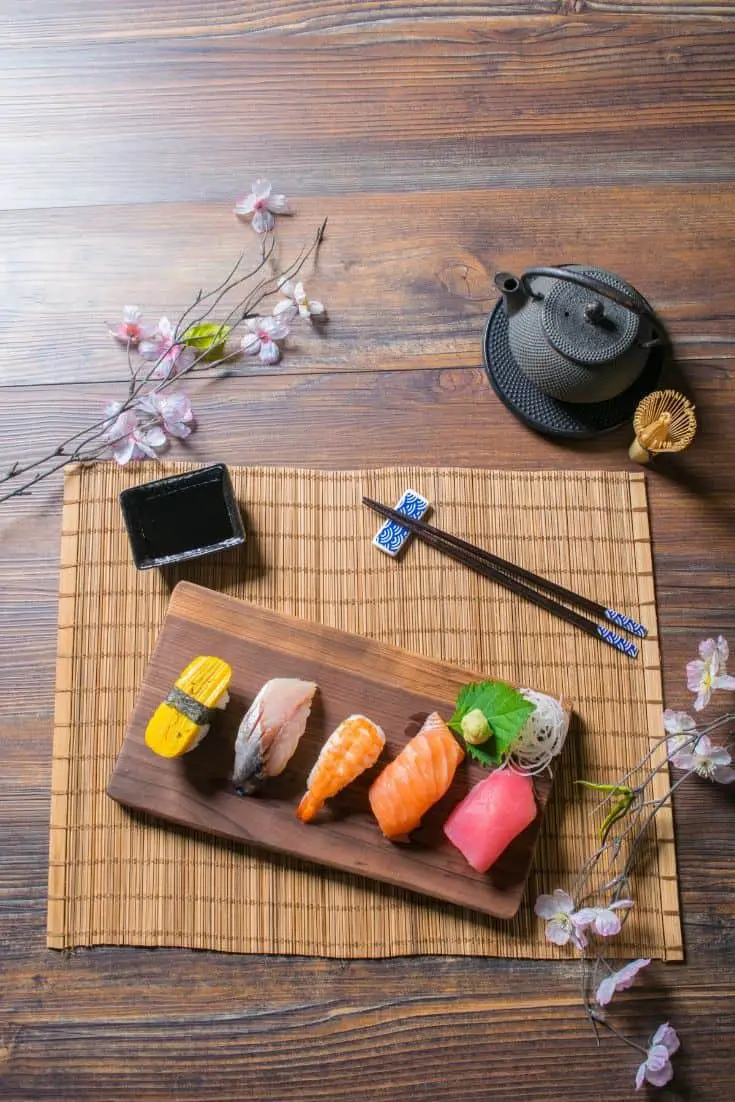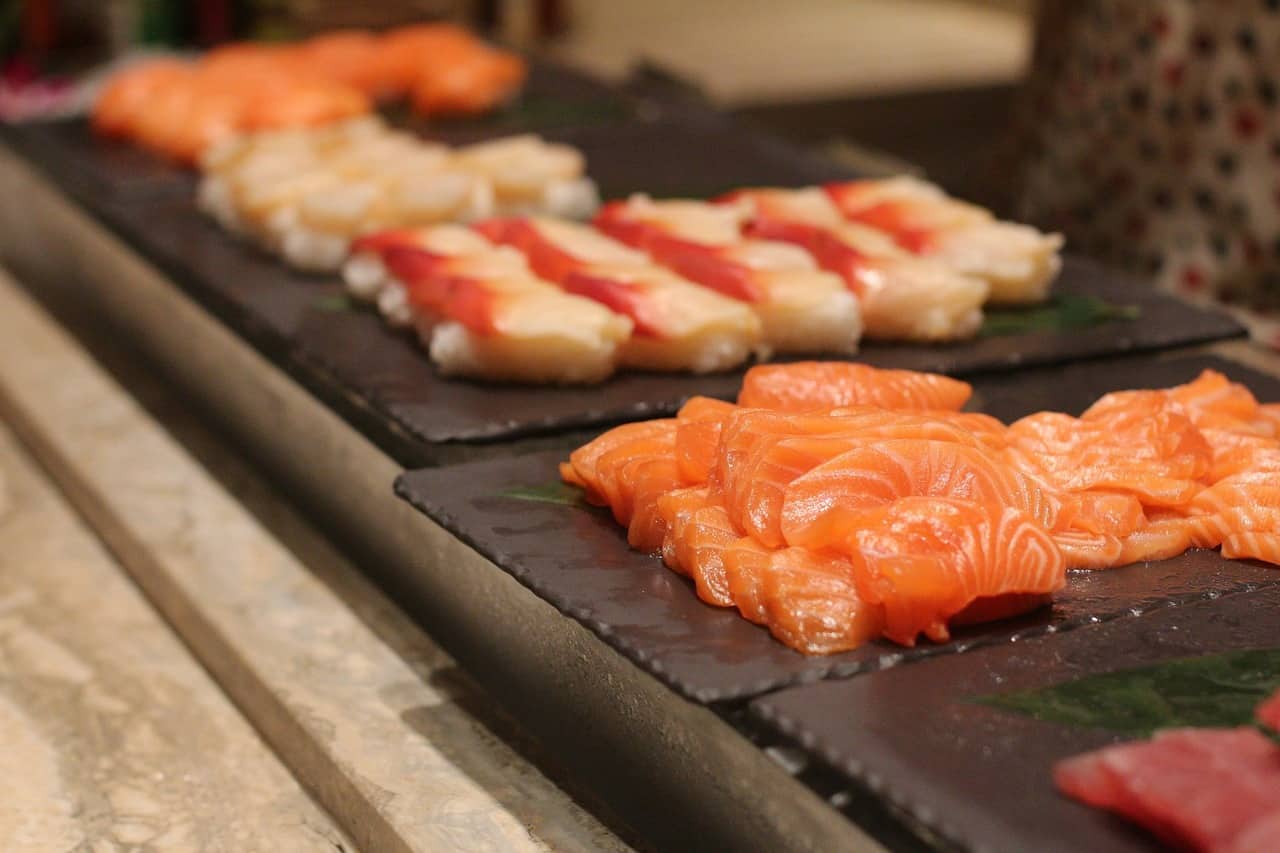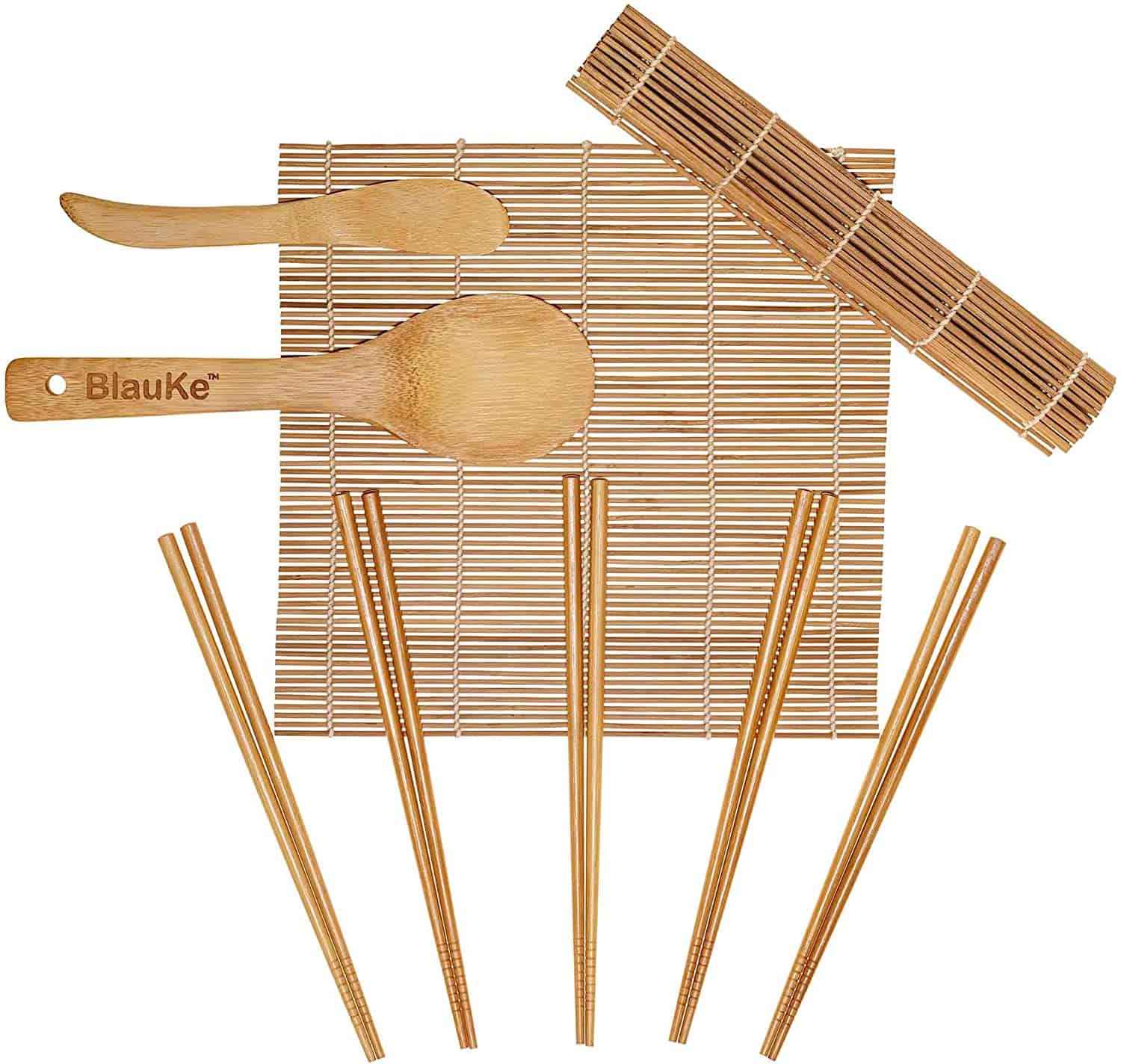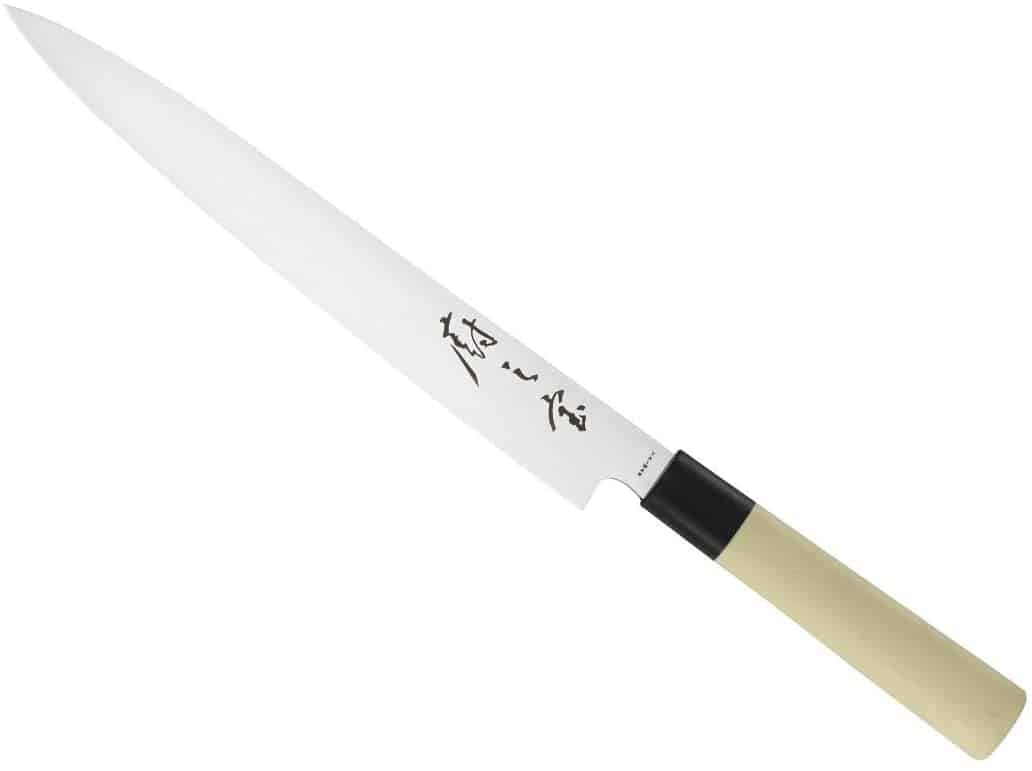Sushi vs. sashimi | the differences in health, cost, dining & culture
Sushi vs. sashimi: the confusion between the 2 world-famous delicacies from Japanese cuisine has been going on since Western tourists discovered it around the Meiji Restoration back in 1867.
In fact, there are a great number of people who are uncertain about the clear difference between sushi and sashimi.
In many countries, the terms “sushi” and “sashimi” are used interchangeably when in fact, these are 2 different types of Japanese dishes! They look similar but there’s a big difference between the two.

At first glance, they may both seem the same, especially since they are both traditional Japanese fish-based cuisines. But once you look closer, you can see that they’re unique to each other and have quite a number of differences.
Today, sushi and sashimi still confuses people and not just those in the West, but even South East Asians who aren’t yet familiar with Japanese cuisine.
So I’ve decided to write this article in order to break down the basic differences between the 2 dishes. Here, I’ll flesh them out so you’ll be able to identify them individually, even at first glance!

Check out our new cookbook
Bitemybun's family recipes with complete meal planner and recipe guide.
Try it out for free with Kindle Unlimited:
Read for freeIn this post we'll cover:
What is sushi?
The basic definition for “sushi” is that it’s vinegared rice mixed with other ingredients, usually seafood and vegetables. It may or may not include raw fish.
There are various ways to make and prepare sushi; however, one key ingredient will always remain and that’s sushi rice. In Japanese, it’s often referred to as shari (しゃり) or sumeshi (酢飯).
Sushi is one of the most popular Japanese dishes in the world. In fact, almost every person in any country knows what the word “sushi” means.
There should be at least one sushi restaurant in every major city in the 195 countries in our world today. The sushi that you’ll order most likely includes raw fish, seaweed, cucumber, nori, omelets, and avocado.
I’ve talked to different sushi chefs and they told us that you don’t need fish to make sushi. This blew me away!
I’ve always thought that sushi translates to “raw fish” or something that’s related to fish. However, this isn’t the case. Sushi may include raw fish but usually, it’s made with cooked fish.
The exact translation for the Japanese word “sushi” is “sour-tasting”. This is because the fish that was first used to make sushi was soaked in a wooden barrel filled with rice and vinegar that fermented the fish.
Who discovered sushi?
It’s believed by historians that ancient Southeast Asian fishermen were the first to discover sushi. However, they can’t pinpoint the exact location of its origin nor do they know its original name.
It had already spread across southern China before the Japanese discovered it and called it nare-zushi (salted fish).
Today, sushi is enjoyed all around the world and has transformed into a contemporary dish. To make it, chefs use various preparation methods, condiments, and ingredients. It’s even evolved to have new subtypes now; namely, handmade sushi, pressed sushi, sushi rolls, and scattered sushi.
Types of sushi
When Japanese connoisseurs refer to “sushi”, they’re referring to a wide variety, as there isn’t just one type of sushi. In fact, there are many and I’ll share the most popular types here!
- Nori maki or makizushi – refers to sushi rolls. The vinegared rice is filled with fresh ingredients and rolled in seaweed sheets called nori paper.
- Gunkan maki – this is a rolled sushi in the form of a battleship. Some space is left at the bottom and filled with various ingredients.
- Temaki – Rice is rolled in seaweed into a cone-shape and filled with ingredients like squid.
- Nigiri – this is not a rolled sushi. A piece of cooked or raw fish is placed on top of a rice mound.
- Narezushi – pungent and fermented rice sushi that isn’t for the faint of heart.
- Oshizushi – this is pressed sushi made in layers and shaped like rectangles.
- Sasazushi – this is rice and fish (usually salmon) wrapped in bamboo leaves instead of nori.
What is sashimi?
Sashimi is another famous traditional Japanese recipe that’s made up of either raw fish or meat sliced into thin pieces and is commonly eaten with soy sauce. Unlike sushi, sashimi is always made with raw fish and seafood and NOT served with rice.
The word sashimi roughly translates to “pierced body” in the Japanese language.
The original term should have been “cut body” instead of what it is now. However, the word “切 る” = kiru (cut) was an exclusive word reserved for samurais during the Muromachi Era (1336 – 1573).
It was even considered too inauspicious to the point of almost superstitious to be used anywhere outside the samurai circles.
On the other hand, sashimi may also derive from an ancient culinary practice in Japan. The chefs/cooks would often stick the fish’s tail or fin to their meat slices in order to identify the fish that has been served on the customer’s table as writing them on paper was time-consuming and too distracting.
Historians also point out that there’s a traditional fishing method in Japan where fish caught by individual handlines are considered “sashimi-grade.” Once the fish lands on the boat or the side of the river, a sharp spike is used to pierce its brain, and then it’s placed in slurried ice.
Fishermen deliberately do the spiking (ikejime) to kill the fish immediately in order for it not to produce any melatonin or lactic acid. That way, its meat remains fresh and delicious to eat for up to 10 days.
Is sashimi better than sushi?
It depends on your personal preference. If you like the taste of fish and seafood, you’ll enjoy sashimi more because the taste is pure and not mixed with other ingredients. However, if you like rice and veggies as fillings, sushi is the food for you.
Sashimi is considered more of a luxurious meal because some types of sashimi are very expensive. So for a more refined dining experience, sashimi is the better option.
The difference between sushi and sashimi
For those who are unfamiliar with Japanese food, they often confuse sushi and sashimi for each other and even go as far as to use them interchangeably. But it only takes a little familiarization with Japanese food and tradition to understand that the 2 dishes are distinct from one another.
Sushi is simply explained as any dish that has to do with vinegared rice.
Traditionally, raw fish was one of sushi’s key ingredients. However, there are many sushi dishes that have cooked seafood in them, while others have no seafood content whatsoever. In fact, vegan sushi is becoming increasingly popular, and the key ingredient in those dishes is veggies like avocado.
By contrast, sashimi is a standalone dish and doesn’t require any side dishes.
Another difference is that while sushi requires having rice that’s been dressed in vinegar, sashimi is always served without rice. It’s simply just thin slices of fish like tuna, salmon, or any other seafood.
Many people assume that sushi is also just a raw fish dish like sashimi. In fact, that’s why many people can’t tell the difference. Here’s what you need to know:
- Sushi is not sashimi.
- Sushi can be made with raw fish.
- The food known as “sushi roll” is actually vinegared rice mixed with other ingredients such as fish, meat, and vegetables, and is rolled with nori sheets.
- A sushi roll can contain raw or cooked ingredients.
Is cooked sushi still sushi?
Yes, most sushi is cooked and not raw. For example, sushi made with eel (unagi) is ALWAYS cooked and never raw.
When you look at sushi rolls, most varieties contain cooked ingredients. The California roll, for example, contains cooked imitation crab meat which is called kamaboko or surimi.
So while raw fish is a common ingredient in sushi, most sushi is made with cooked ingredients.
How do chefs prepare sushi and sashimi?
Chefs often prefer saltwater over freshwater fish when preparing sashimi. That’s because freshwater fish tend to have parasites that could cause food poisoning and other intestinal problems.
It’s true that sushi chefs also use sliced raw seafood when preparing sushi dishes. However, it can’t be considered sashimi as long as it’s paired with vinegared rice.
In order for it to be called a sashimi dish, it must be served without any side dishes, especially rice.
Normally, when you dine in a Japanese restaurant and order sashimi, it’ll be served to you on top of shredded daikon (white radish) along with pickled ginger, wasabi, and soy sauce.
In high-end Japanese/sushi restaurants, the fish are alive in fish tanks, ready to be prepared and freshly served for the customer.
Common types of fish and seafood in sashimi
Below is a list of fish types that are used to make sashimi dishes:
- Salmon
- Tuna
- Horse mackerel
- Octopus
- Fatty tuna
- Scallop
- Sea urchin
- Sea bream
- Yellowtail
- Squid
- Shrimp
- Clam
From this, we can tell that sushi can have sashimi as part of its ingredients. But its core ingredient is rice dressed in vinegar. On the other hand, sashimi can’t be served with rice, but by itself only.
Also read: this Japanese sushi eel is called unagi and it’s delicious
Pricing
- Sushi – ¥10,000
- Sashimi – ¥500 – ¥1,200 (izakaya) and ¥800 – ¥1,600 at more expensive places
Why is sashimi more expensive than sushi?
Sashimi is made from high-quality ingredients, meaning fresh fish and seafood. The fish is more expensive because it isn’t commercially exploited or farmed fish.
The catching method influences the price of the fish or seafood. Fish that’s used in sashimi is most often caught by line, which is the most time consuming and labor-intensive fishing method. So it’s normal that the price is higher.
Sushi vs. sashimi nutrition

When talking about nutrition for sushi vs. sashimi, it’s hard to get an exact figure as ingredients vary with both dishes. However, I can give you a ballpark figure.
Comparing calories, it’s clear that sashimi is the winner. This is because a piece of sashimi only has 20 – 60 calories and fish meat has lots of other health benefits too.
Health and nutritional information
The benefits of eating sashimi regularly are:
- Get iodine and omega-3 fatty acids
- Lower your risk of heart attacks and strokes
- Get nutrients that are crucial for growth and development
- Boost your brain health
- Prevent and treat depression
- Get a good source of vitamin D
- Reduce the risk of autoimmune disease
- Prevent asthma in children
- Keep your vision sharp through old age
- Improve sleep quality
On the other hand, sushi rolls have around 200 – 500 calories on average. This is mostly due to the rice in the sushi.
Nigiri sushi is known to have similar calories to sashimi, with roughly 40 – 60 calories apiece.
The rice in sushi is actually called vinegared rice and it contains vinegar, salt, and a good amount of sugar, which is why it’s high in calories.
So if you’re looking for a healthier choice, then you should eat sashimi more than sushi, although sushi can sometimes taste better.
I guess it’ll be a battle of will versus cravings then!
Is sashimi healthier than sushi?
If you consider the nutrients and calories, sashimi is the healthier option, especially for those on a diet. Sashimi made with fish is high in omega-3 fatty acids, which are good for the body.
Some of the health benefits of omega-3 include lower blood pressure, improved heart health, and reduction in triglycerides. As well, sashimi is high in protein and low in carbs and calories.
On the other hand, sushi has more carbs; therefore, more calories. This is due to the fact that sushi contains rice (which has many calories) and lots of fillings such as meats, fish, seafood, and vegetables.
Since there are so many varieties and different ingredients for sushi, the number of calories varies a lot. But sushi made with fish is also high in omega-3 fatty acids, which makes it a healthy option in many ways.
But if you put a lot of soy sauce and Japanese mayonnaise as toppings, you’re increasing your sodium and calorie intake quite a lot.
Sushi vs. sashimi safety concerns
Forgive me for using Uncle Ben’s famous line from the Spider-Man comic books: with great food comes great health risks (paraphrased with pun intended). I use it because there are safety issues associated with sushi and sashimi.
But high-end sushi/sashimi restaurants have a reputation to keep. So you can rest assured that they go to great lengths to make sure that their food is safe.
One of the main safety concerns is fish and seafood meats. If they’re not placed inside a freezer, then they’ll most likely get bacterial growth and time is the killing factor for these types of foods.
If you’re getting sushi from the supermarket, make sure that the fish is prepared recently (maximum time allowed out of the ice is 10 hours). If the fish or seafood is pre-cooked, there’s no cause for worry.
In rare cases, parasitic worms show up in fish meat. But most local market vendors and high-end restaurants follow strict protocols in making their food safe for consumption.
Can you eat raw food like sashimi?
It’s safe to eat raw fish and seafood, as long as it’s prepared in a clean environment. As well, the most important thing is that the fish is fresh.
Here are some of the potential threats:
- If the fish isn’t fresh, it can be rotten and crawling with bacteria.
- You can tell if the fish isn’t fresh by the scent. When fish and other seafood goes bad, it has a strong foul smell and that’s how you know the food isn’t fit for consumption.
- Sashimi and sushi may be infested with parasites that aren’t visible to the naked eye. These can cause illnesses in the form of food poisoning or something even more serious.
- People with a weak immune system and pregnant women shouldn’t eat raw meat.
But if the raw food is prepared with fresh ingredients and served in a clean environment, you can eat it safely.
Do sushi and sashimi contain mercury?
Pregnant women should avoid eating sushi or sashimi, as the fish used for making these dishes often has a high methylmercury content.
Methylmercury is a naturally-occurring chemical compound in the ocean and it passes on from prey to predator.
Unfortunately, shark, swordfish, mackerel, tilefish, and tuna are all at the top of the food chain, so they get a more concentrated amount of methylmercury than, say, the amberjack. This makes them unsafe to eat, as the methylmercury in them could potentially cause abnormal development for the baby in the mother’s womb, or worse – kill it.
But if you’re not pregnant and have no related allergies concerning sushi, sashimi, or any other seafood, then you can eat these dishes at the recommended amount!
Are sushi and sashimi street food, party food, or fine dining food?
When you walk around major cities today, you’ll find lots of sushi and sashimi restaurants. Sushi isn’t sold at a food stall; instead, it’s served at restaurants and grocery shops.
But once upon a time in ancient Japan in Edo (modern-day Tokyo), sushi and sashimi weren’t that sophisticated. They were considered “common” food, although not necessarily street food.
It also wasn’t considered haute cuisine during the 1600s, nor was it similar to what we eat today.
It was also during the Edo Period where chefs started using freshly caught fish for sushi and sashimi. These cuisines evolved from fish in a fermented form served at a later time to it being eaten right after preparation.
This was obviously limited in scope because of the lack of good ways to preserve raw fish for a while yet.
It’s also important to note that hand-shaped sushi was Edo-style sushi as opposed to the box-shaped sushi, which was Osaka-style sushi.
The 20th century
At the turn of the 20th century, during the Meiji Restoration, Japanophiles (foreigners who appreciate and love of Japanese culture, people, and history) were first introduced to Japanese culture, and sushi became one of their food novelties and stuff of curiosity.
Naturally, these foreigners who had visited Japan recounted their experiences with their family, friends, and even strangers. Some would bring home a sample of sushi/sashimi. Others would prepare and serve sushi so their friends and family could try these delicious dishes.
On the other hand, Japanese communities that lived overseas also shared Japanese cuisines with their non-Japanese neighbors and friends, including sashimi and sushi.
Over time and due to the complexity of the preparation required for these dishes, they became a delicacy almost exclusively for fine dining and later on for home cooking as well when cookbooks and food & drink blogs were invented.
So we can conclude that sushi and sashimi are both fine-dining and party food. It’s no longer a street food, as it hasn’t been one since the Meiji Era.
How are sushi and sashimi served?
Both sushi and sashimi are most often served with soy sauce, wasabi, and pickled ginger.
Some specialty restaurants offer some unique toppings to go with sushi and sashimi. But if you want to make sushi at home, you can stick to the basics of wasabi and soy sauce, and dip your sushi rolls into them.
Most popular toppings for sushi and sashimi
There are many tasty toppings for these dishes. Here’s a list of the most common one:
- Sesame seeds
- Soy sauce
- Wasabi
- Pickled ginger
- Avocado
- Seaweed salad
- Green onions
- Spicy seafood
- Mangos
- Thin slices of fish
- Sliced almonds
- Chia seed
- Shrimp
- Crab salad
What tools do you need to make sushi and sashimi?
For easy cooking, you need some special Japanese utensils to make sashimi and sushi.
For sushi, you need:
A bamboo mat to roll your sushi.
Here’s a kit with a bamboo mat, chopsticks, a rice spreader, and a paddle.

For sashimi, you need:
A gyutoh, which is a Japanese chef’s knife. Chefs use this type of knife to slice raw meat into very thin slices, especially fish and seafood. If you want to make good sashimi, you must have a sharp knife.
Look for a quality knife designed for making sashimi. Here’s a good option from the Mercer Culinary Asian Collection:

Check out all of the best sushi and sashimi knives in our post here
Final thoughts on sushi vs. sashimi
It’s actually not a good thing to make people choose between sushi and sashimi, simply because both dishes are amazing. And the best thing about them is that anyone can enjoy the kind of sushi or sashimi that they want because they have a lot of varieties!
Not into the whole raw fish thing? There are sushi varieties that have cooked seafood in them.
You’ve tried raw fish a few times before or want to get into it? Most sushi varieties use raw fish or other seafood types in them.
So start exploring sushi and sashimi restaurants now and look for the best variety that suits your taste. Soon, you’ll find the sushi or sashimi variety that will become your favorite.
However, I encourage you to keep trying different ones occasionally.
Who knows? You might find a second or third favorite sushi/sashimi variety along the way.
Check out our new cookbook
Bitemybun's family recipes with complete meal planner and recipe guide.
Try it out for free with Kindle Unlimited:
Read for freeJoost Nusselder, the founder of Bite My Bun is a content marketer, dad and loves trying out new food with Japanese food at the heart of his passion, and together with his team he's been creating in-depth blog articles since 2016 to help loyal readers with recipes and cooking tips.
